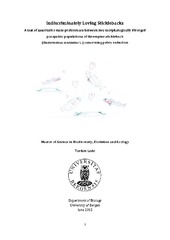Indiscriminately Loving Sticklebacks. A test of assortative mate preferences between two morphologically diverged parapatric populations of threespine stickleback (Gasterosteus aculeatus L.) concerning pelvic reduction
| dc.contributor.author | Lode, Torben | eng |
| dc.date.accessioned | 2013-09-09T11:48:32Z | |
| dc.date.available | 2013-09-09T11:48:32Z | |
| dc.date.issued | 2013-06-07 | eng |
| dc.date.submitted | 2013-06-07 | eng |
| dc.identifier.uri | http://hdl.handle.net/1956/7078 | |
| dc.description.abstract | Two parapatric populations in western Norway in which one have completely reduced its pelvic complex are tested for assortative mating being an important mechanism in maintaining barriers keeping them from mixing in their contact zone. Three predictions are launched and tested: 1. Females from both populations prefer mating homogeneously with males from their own population; 2. Females may mate with males from both populations, but spawn larger clutches for males from their own populations; 3. Males from both populations prefer mating homogeneously with females from their own population. Weak and contrasting patterns emerge regarding female preferences, while male preferences can indicate homogeneous mate choice. In conclusion, the existence of assortative mating cannot be ruled out, but it seems not to be the most likely candidate to prevent hybridization and preserve the sharp morphological distinction between these two parapatric populations of threespine stickleback. | en_US |
| dc.format.extent | 1527676 bytes | eng |
| dc.format.mimetype | application/pdf | eng |
| dc.language.iso | eng | eng |
| dc.publisher | The University of Bergen | en_US |
| dc.title | Indiscriminately Loving Sticklebacks. A test of assortative mate preferences between two morphologically diverged parapatric populations of threespine stickleback (Gasterosteus aculeatus L.) concerning pelvic reduction | en_US |
| dc.type | Master thesis | |
| dc.rights.holder | Copyright the author. All rights reserved | en_US |
| dc.description.localcode | MAMN-BIO | |
| dc.description.localcode | BIO399 | |
| dc.subject.nus | 751999 | eng |
| fs.subjectcode | BIO399 |
